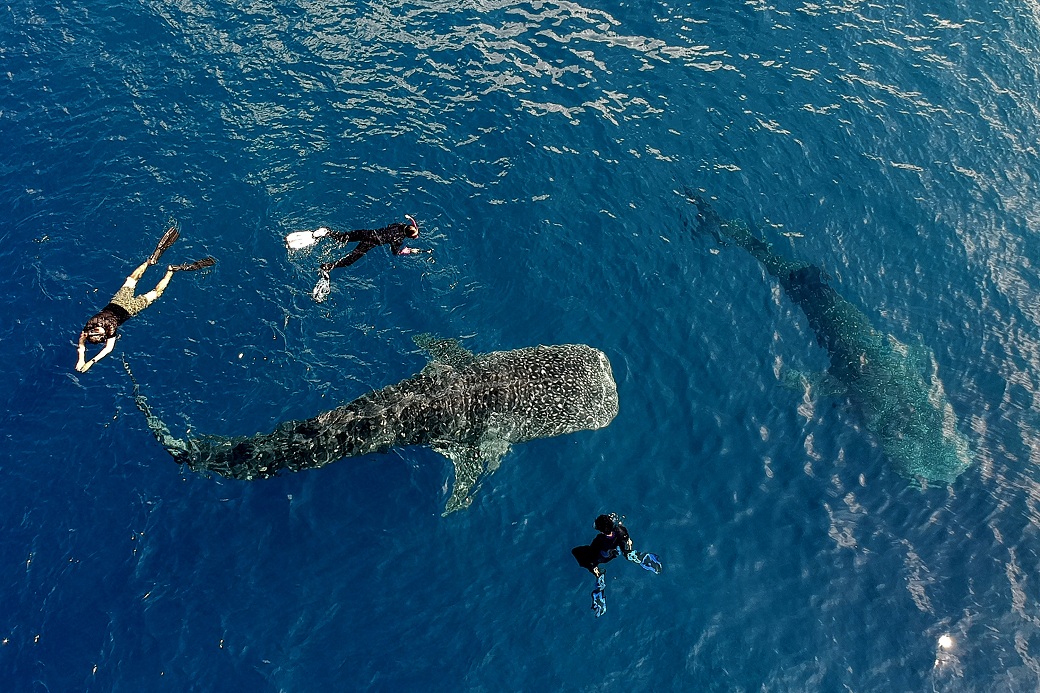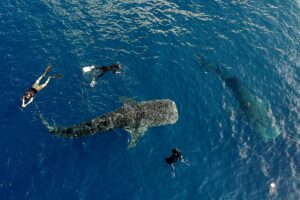
Sejumlah wisatawan berenang bersama seekor Hiu Paus di perairan Botubarani, Kabupaten Bone Bolango, Gorontalo, Minggu (21/4/2019). Pengamat mencatat bahwa puncak musim kedatangan kelompok Hiu Paus ke perairan tersebut yaitu pada bulan Mei dan Juni. ANTARA FOTO/Dian Bawenti/Aws/hp.
It was early January when I finally decided to tick off one of my long-time dreams — swimming with whale sharks. I had read so many articles, watched countless YouTube videos, and saved a dozen Instagram reels about this majestic encounter in Saleh Bay, Sumbawa. But here’s the twist: it was the middle of the rainy season.
“Is it still worth going?” That was the big question on my mind. I was nervous, excited, and skeptical all at once.
But let me tell you what I learned.
The Rainy Season Misconception
When people hear “rainy season,” the instinct is to avoid travel — especially for outdoor or marine activities. Most travelers assume that rain equals zero visibility, choppy waters, and gloomy skies. That might be true in some places, but not in Saleh Bay.
In fact, the locals told me something unexpected: whale sharks are actually spotted consistently throughout the wet season, especially around December to March. I didn’t believe it at first either.
Apparently, the fishing platform activities (bagan) continue year-round, and that’s where the whale sharks love to hang out — rainy skies or not.
So, yes — the weather might look grey, the air a little moist, but the ocean? Still brimming with life.
My First Whale Shark Encounter (Yes, It Was Raining)
The boat ride started before sunrise. A light drizzle tapped the canopy, and I wrapped myself in a poncho, half-hoping the skies would clear. But you know what? The crew was smiling like it was any other perfect day.
About an hour into the trip, the boat slowed down. I peered over the edge and my heart skipped — there it was, a massive, gentle shadow just below the surface.
A whale shark. My first one.
The rain didn’t matter. The sky could’ve been purple, and I wouldn’t have noticed. Being in the water with that giant — calm, graceful, majestic — was something else. I’d never felt more alive.
That moment lasted maybe 20 minutes, but it’s burned into my memory forever.
Water Conditions and Visibility: Not What You Think
Here’s the cool part. Saleh Bay is relatively protected, which means the water is calmer than the open sea — even during the rainy season. Visibility can fluctuate, sure, but I still had 5 to 10 meters of clear sight underwater, which is more than enough to fully enjoy the encounter.
The rain doesn’t muddy the water here as much as you might expect. In fact, cloudy skies often mean less glare on the surface, which makes it easier to spot these gentle giants from the boat.
So, if you’re holding back from booking your tour just because it’s not a sunny month, let me say it: don’t wait for perfect weather to chase perfect memories.
Whale Shark Behavior in Wet Season
One of the guides told me something fascinating — during the wet months, whale sharks are often more relaxed and curious. Maybe it’s the cooler water or the fewer tourists, but they tend to linger longer around the boats.
Sometimes, they even come closer than expected. One of them brushed past my fins so gently that I nearly cried in my snorkel mask. That level of connection with wildlife is hard to describe.
It felt less like a tourist activity and more like an exchange between worlds.
Not Just Whale Sharks: The Whole Experience
Saleh Bay in the rain has its own kind of beauty. The mist hanging over the water. The dramatic clouds hugging the hills. The quiet — oh, the quiet.
It wasn’t crowded either. One of the perks of coming during the off-peak season is that you sometimes have the whole area to yourself. That means more time in the water, less rushing, and the luxury of soaking in the moment without a dozen GoPros competing for space.
And the team from <a href=”https://whalesharksalehbay.com/”>Saleh Bay whale shark tour</a>? Absolutely amazing. They knew exactly where to go, handled everything with care, and made us feel safe the entire time.
This wasn’t just another check on the bucket list — it was a connection to nature I didn’t know I needed.
Keyword Synonyms You Might Be Searching For
If you’ve been searching terms like “Sumbawa whale shark experience,” “swim with whale sharks Indonesia,” “best time to see whale sharks,” “whale shark season Sumbawa,” or “ethical whale shark tours”, let this be your sign.
Whatever you call it — an adventure, a wildlife trip, a bucket list goal — the whale shark trip Sumbawa is absolutely worth it. Rain or shine.
I used to think dry season was the only time to go. Now? I know better.
Tips If You’re Coming in Rainy Weather
If you’re considering a trip during the wet season, here are a few things I’d recommend:
- Bring a light waterproof jacket for the boat ride — not for warmth, but just to stay dry.
- Dry bags are your best friend for electronics and clothes.
- Go early in the morning. Whale shark sightings often happen just after sunrise.
- Stay flexible. Weather might change, but the tours often adapt very well to conditions.
- Trust the local guides. They’ve done this hundreds of times. They know what they’re doing.
And most importantly — let go of expectations. You might not get blue skies, but you will get memories that last a lifetime.
Still Wondering If It’s Worth It?
You’re not alone. I almost cancelled my trip because the forecast showed rain all week. But thank goodness I didn’t.
What I got wasn’t just a chance to swim with whale sharks. It was a chance to see nature in its raw, unfiltered form. A reminder that beauty doesn’t always come with sunshine. Sometimes, it shows up in the rain — in quiet waters, under grey skies, beside a giant fish that looks you in the eye and says, “Welcome.”
So yes, it’s worth it. Every single second of it.
If you’re dreaming of an unforgettable encounter, consider taking your own <a href=”https://whalesharksalehbay.com/”>Saleh Bay whale shark tour</a> — no matter the season.





